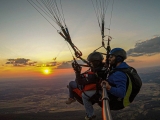Introduction
There’s something extraordinary about feeling snow beneath your feet on skis while spotting boats near the Granadan coast—or even glimpsing mountains on another continent. You gaze into the valley and find a vibrant city, sprawling around industrial hubs, thriving thanks to the surging water flowing from these snow-capped peaks.

The Alhambra
It’s no surprise the Arab people settled at the foot of this mountain range. Its elevation provided secure vantage points and shelter from winds, while the land—fed by melting snow—remained fertile.
The history of skiing in Sierra Nevada predates even the Arabs’ arrival in Andalusia. Records show that in the 12th century, Abu Hamid, during travels to Asia, documented indigenous people using skis to traverse snow—arguably describing mountain skiing. Contemporary archives detail these early skis.
Jumping to modern times, accounts of skiing here emerged by early 1914. By 1928, the Second Sports Week featured a race up Veleta Peak with skis and crampons. Unsurprisingly, the station’s pioneers were avid mountaineers.
Countless ski routes now crisscross Granada’s mountains. Before mechanised lifts arrived in the 1960s, climbers charted paths using seal-skin skis, ascending slopes and scouting safe passages—or hauling touring skis to summits before exhilarating descents through hidden valleys accessible only to those willing to trek.

Mechanisation then lured the less adventurous to skiing, making the sport more approachable.
Resorts expanded, with grand hotels and apartment blocks catering to tourists. Skiing commercialised, yet high costs—for gear and upkeep—initially reserved it for a privileged few.
When Andalusia’s regional government took over, they prioritised public access. By the mid-1980s, Sierra Nevada launched affordable packages, positioning itself as a prime holiday destination. Reasonable prices and full-service offerings followed.
Renamed from "Pradollano Station" to "Sierra Nevada," its appeal broadened: dazzling descents, protected wildlife, unique sunsets, sea views from summits—images that captivated visitors and galvanised locals to champion the mountain’s tourism and ecology.
In 1977, Sierra Nevada hosted the Alpine Ski World Cup finals—a niche event then, as skiing remained exclusive. Yet within a decade, it staged major international competitions, eyeing the World Championships.
Ambition matched growth: after flawlessly organising the 1996 Alpine World Ski Championships, this southern Spanish station—overlooking the sea and nearly touching Africa—earned global acclaim among top ski and snowboarding destinations.

The Skiable Domain
Multiple routes lead to Borreguiles, the hub for lifts, ski schools, and restaurants, serviced by the Al Andalus and Pradollano cable cars—the main arteries to the slopes.
Borreguiles hosts wide, beginner-friendly runs with two ski-tows and a chairlift easing learners into gentle gradients, ensuring safe descents for novices.
From here, lifts ascend to advanced zones—all meticulously groomed overnight into pristine "motorways."
El Águila Run Area
After riding Borreguiles’ ultra-fast Veleta II chairlift, choose from multiple descents back to base—via Río Valley or Cauchiles Valley, the latter home to the "World Cup Run" (named for the 1977 finals).
For higher thrills, ascend toward Veleta Peak. At 3,100m, opt for a 900m vertical drop to Pradollano or head to Laguna de las Yeguas Valley, where a high-speed chairlift delivers you to the resort’s highest point—almost within reach of the Mediterranean, just 20km away.

Alternatively, the Monachil chairlift accesses its namesake valley’s broad, intermediate-friendly slopes (beginners beware). While Borreguiles is forgiving, Veleta’s steep pitches demand skill—especially on icy spring mornings.
Cauchiles suits confident intermediates (parallel turns, no fuss). Monachil is reliably straightforward. Las Yeguas shines in deep snow but watch for ice-hard bumps and traverses.
Snowboarders get a dedicated freestyle zone—a buzzing snowpark drawing riders nationwide for sun, powder, and music.
Off-Piste
Options abound across Sierra Nevada’s vast terrain. Each valley offers backcountry routes—from powder havens to extreme challenges. While not famed for off-piste, gems exist: Henry’s Direct Line (Cauchiles) is a low-technical favourite, while Laguna’s "Los Tajos de la Virgen" demands expert skills—steep entries and avalanche risks (always check conditions first).
Many off-piste areas remain visible from lifts, ensuring safety. For example, Monachil’s backcountry—moderate and always returning to Río Run—is easily spotted from cable cars.

Après-Ski
Sierra Nevada dazzles off the slopes: endless restaurants, ice rinks, cinemas, shops, and supermarkets. Or venture 30km to Granada’s wonders. Don’t miss Crescendo Lodge’s burgers (and epic terrace) or Cartujano’s tapas—where Juan and his wife serve with pride.
Ski Mountaineering
Sierra Nevada sits in the Penibético Range. From Veleta, gaze across valleys and peaks like Mulhacén, Trevélez, or Pampaneira—all ripe for exploration.
Nordic Skiing
While not a Nordic stronghold, Sierra Nevada offers 4km of tracked trails plus 9km across six routes. For dedicated cross-country, ask about Puerto de La Ragua—nearby and ideal for enthusiasts.











